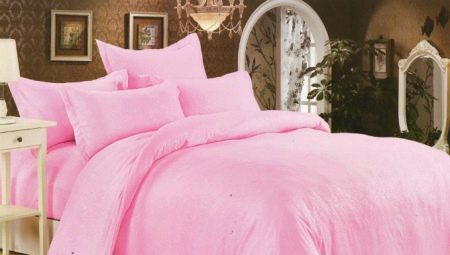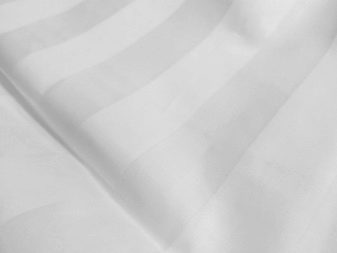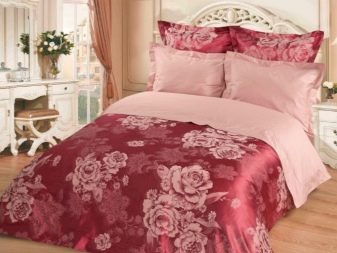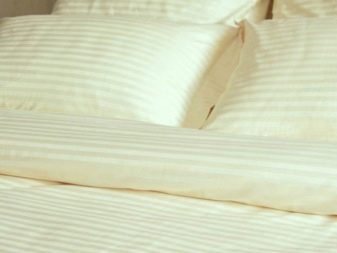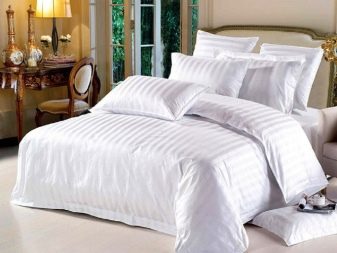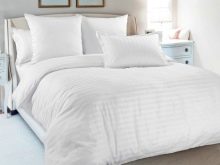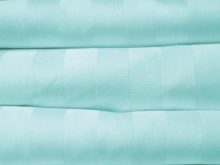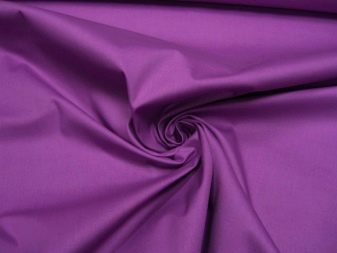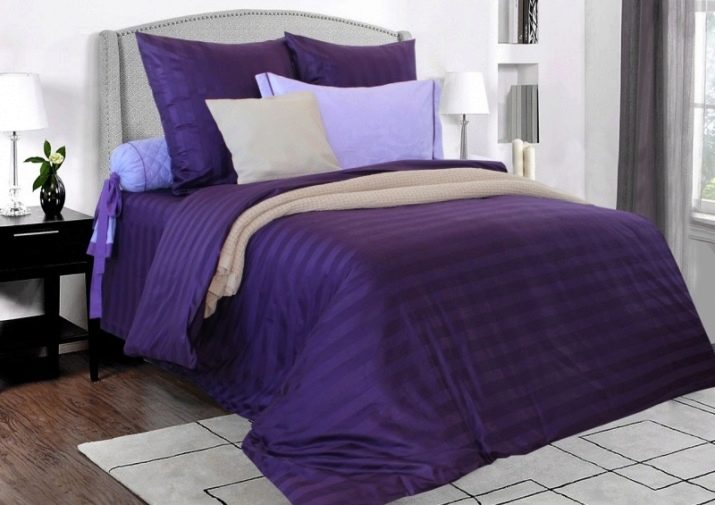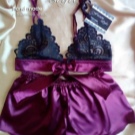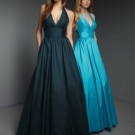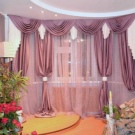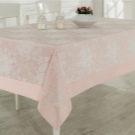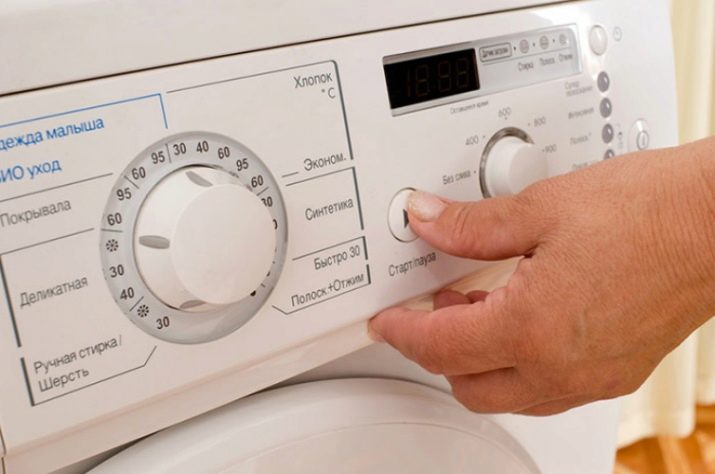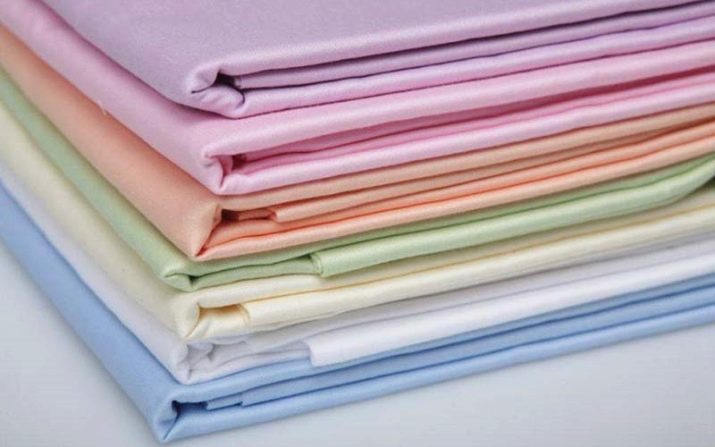Stripe satin is a variation of jacquard satin. Fabric is in high demand, has excellent performance characteristics and good decorative properties. The material is widely used for sewing bedding sets, bedspreads and clothing.
Composition and properties
Streyp-satin refers to luxury fabrics and has a shiny surface with a clearly marked two-sided pattern, consisting of alternating strips of glossy and matte performance. The name stripe-satin is also due to the presence of strips, which are translated into English as stripe.
The brilliant spectacular surface is obtained with a special method of weaving threads., during which one duck overlaps four warp threads, moving one thread with each new row. Thanks to the front weft flooring, the formed web acquires extraordinary smoothness and beautiful iridescent sheen. By its composition, stripe-satin is completely natural and consists of 100% cotton. However, to give the material a greater decorative effect, sometimes lycra is added to its composition, which is why shiny stripes look more elegant and are effectively shaded by matte.
In addition to the fact that the material looks quite stylish and elegant, it is highly resistant to mechanical stress. Without loss of brightness of paints and without loss of the original forms, the fabric is able to transfer over 300 wash / ironing cycles, which is a rather high indicator for materials of this category.
In addition, in the manufacture of fabric manufacturers use only natural dyes, which in combination with cotton composition makes the fabric completely hypoallergenic and environmentally friendly. The dye is applied to the yarn immediately before the beginning of the weaving, and the technology with which dyeing occurs allows the dye to penetrate deep into the fibrous structure of the yarn. At the final stage of production, the sheets undergo a special treatment that protects the surface of the material from loss of gloss and burnout.
Advantages and disadvantages
High consumer demand and a large number of encouraging reviews about stripe satin due to a number of indisputable advantages of this material.
- The fabric is quite strong and durable, which is explained by the relatively high density, ranging from 140 to 180 g / m2.
- Stripe satin is not prone to flaking, which is why it is easy enough to cut and sew.
- The material is not subject to deformation and shrinkage, which allows not to worry about preserving the original appearance of things after washing.
- A variety of geometric patterns and shades greatly facilitates the selection and allows you to purchase fabric for every taste.
- Despite the fact that the surface of the material is smooth and silky, bed linen, made of stripe satin, does not stick to the skin and does not crumple.
In addition to the obvious advantages, Stripe Satin has its weak points. First of all, it is low breathability. The material is not able to provide a complete air exchange, which is why it is rather uncomfortable to sleep on bed-clothes made from this fabric during the summer period. Another disadvantage is the high cost of stripe-satin products, which, however, is fully explained by their natural origin.The disadvantages include the fact that in the presence of a mattress with a synthetic covering sheet often slips off the bed, which causes certain inconveniences when using bedding sets. However, on soft sofas and cotton mattress covers, the fabric behaves differently and does not cause disturbances to the sleeping.
Application area
The scope of use of the material is quite wide. It is often used for sewing bedding sets, underwear, dresses, men's shirts, curtains, curtains, tablecloths and bedspreads, and is also used as a lining fabric for dresses and raincoats. At the same time, clothing and bedding are sewn from less dense types of stripe-satin, the density of which varies from 120 to 150 g / m2, whereas home textiles, curtains and bedspreads require the use of a more dense and rigid material with indicators of 180 g / m2.
Even a beginning seamstress can sew any product from a stripe satin. This is due to the fact that, thanks to the presence of well-visible strips, it is not difficult to lay a perfectly flat line. The high decorative qualities of the fabric are also due to the fact that the presence of stripes is well suited for many styles. For example, striped curtains, rugs and tablecloths can perfectly fit into the English interior. A strict geometric pattern is well suited for sewing business clothes, such as suits, dresses or skirts.
All models of clothes, made of stripe satin, are distinguished by high wear and do not lose their original appearance for a long time. Styles for such things are usually chosen the most simple, because the fabric itself is very beautiful and does not need the presence of a large number of decorating parts.
Criterias of choice
The main criterion for the choice of stripe satin is its functional purpose. So, if not a finished product is purchased, but a piece of fabric, then its quality, color and operational characteristics are selected on the basis that it will be sewn. For bed sets it is recommended to purchase canvases of white and light tones, with a density not higher than 150 g / m2. Too dense fabric will not provide even the minimum ventilation, and sleeping on such clothes will be extremely unpleasant. If stripe-satin is bought for sewing curtains, bedspreads or tablecloths, then in this case you need to buy a fabric of maximum density. Such products will perfectly keep their shape and will not hang down after the first wash. And when buying a material that will be used as a lining fabric for skirts and outerwear, on the contrary, it is better to choose the thinnest and least dense canvas.
The density of the material is usually indicated in the accompanying documentation, but if you can’t see it, you can determine the approximate density visually. To do this, look through the canvas to the light. The outlines of people and objects in this case should be vague and fairly vague. If, however, everything that is happening around is clearly visible through the fabric, then, most likely, on the counter there is either a fake or a material, during the manufacture of which the production technology was violated. Therefore, it is better to refuse such a purchase. You should also check if there is a mercerization mark in the documents. If such a mark is, then the fabric can be safely bought and not to worry that the brilliance and brightness of colors will disappear after the first wash.
Care instructions
Despite the fact that stripe satin is classified as undemanding in the care of materials, some rules for its washing must still be observed. First, wash items from this fabric should be separated from other things. In no case should the material be placed in a drum along with rigid polyester fabrics, as well as clothes decorated with rhinestones, beads or sparkles. Otherwise, there is a risk that the threads will be stretched out of the stripe satin, after which it will be impossible to remove the puffs.Secondly, it is important to observe and temperature. The optimum temperature is from 40 to 60 degrees. Moreover, it is better to wash low density material in cooler water.
In addition, pillowcases, duvet covers and clothing should be turned inside out before being placed in a typewriter, it is also recommended to be dried in an inverted form. This will prevent the appearance of pellets and will contribute to a better prostration products. It is forbidden to add bleaching compounds when washing colored fabrics. Otherwise, due to the inhomogeneous structure of the material, light stains and spots may appear on its surface, which cannot be eliminated. For washing white products it is recommended to use sparing bleaching agents that do not contain chlorine.
It is better to dry stripe-satin things in the open air, and you don’t need to achieve complete drying: the wet fabric is ironed much better and does not need additional moistening. Ironing products is recommended only from the reverse side of the heating mode "Cotton". After ironing, leave the clothes for a while on the hangers and only then put them in the closet. This will allow the moisture remaining in the seams to evaporate, and will not allow things to clot during long-term storage.
Buying stripe satin, consumers, as a rule, do not regret their choice. Indeed, despite some shortcomings, the fabric is able to make a variety in any interior, become the decoration of the wardrobe and ensure a quiet and comfortable sleep.
What is stripe satin and how to distinguish it from other fabrics, see the next video.
